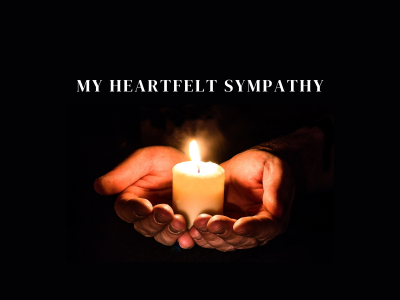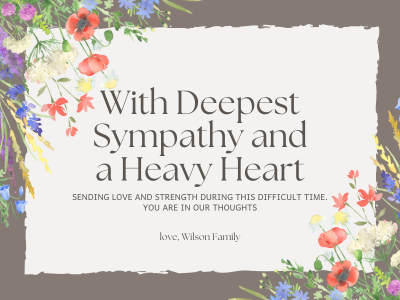Sympathy: The Key Ingredient for Strengthening Community Bonds
In a world that often seems divided, finding ways to strengthen community bonds is more important than ever. One key ingredient that can bring people together is empathy. Sympathy, a close cousin to empathy, has the power to build bridges and foster connection. Not only does a message of sympathy help individuals feel supported and validated, but it also plays a vital role in building trust and promoting collaboration.
When we express sympathy, we acknowledge and understand the feelings of others, showing that we care and are willing to support them. It creates a sense of shared understanding and unity, breaking down barriers that may exist within a community.
By showing sympathy, we create an environment where people feel comfortable expressing themselves and seeking help when needed. It establishes a strong foundation for open communication and problem-solving.
We will explore the significance in strengthening community bonds. We will delve into how acts of sympathy can contribute to a more compassionate and united society. So, let's dive in and discover the transformative power of sympathy in fostering connections within our communities.
Content:
- Understanding sympathy
- The importance of sympathy in community bonds
- Sympathy vs empathy: the diference explained
- The benefits
- How to cultivate sympathy in your community
- Sympathy-building activities and initiatives
- The role of leaders
- Case studies: successful examples of sympathy in action
- Overcoming obstacles
- Conclusion: the power of sympathy in building strong communities
Understanding sympathy

Sympathy is often confused with empathy, but they are not the same thing. While empathy involves putting yourself in another person's shoes and feeling what they feel, sympathy is more about acknowledging and understanding their feelings without necessarily feeling them yourself.
For example, if someone is grieving the loss of a loved one, you can express sympathy by saying, "I am sorry for your loss," or "I can only imagine how difficult this must be for you." By doing so, you are acknowledging their pain and showing that you care.
Sympathy is not about fixing the problem or providing a solution. It is about being present with the person and offering support in a way that feels comfortable for them.
The importance of sympathy in community bonds
The correct sympathy message is a vital ingredient in building strong community bonds. It helps to create a sense of belonging and fosters a culture of compassion and kindness. When individuals feel seen and heard, they are more likely to engage with others and form meaningful connections.
Sympathy can be especially important in times of crisis or tragedy. When a community experiences a collective trauma, such as a natural disaster or a mass shooting, expressing sympathy can help to ease the pain and bring people together. It can also be a way to honor those who have been affected and show support for their loved ones.
In addition to its emotional benefits, sympathy can also have practical advantages. By fostering a culture of sympathy, we create an environment where people feel comfortable asking for help when they need it. This can lead to increased collaboration and problem-solving within the community.
Sympathy vs empathy: the difference explained

While sympathy and empathy are closely related, there are some key differences between the two. Empathy is about feeling what another person feels, while sympathy is about acknowledging and understanding their feelings.
Empathy requires a high level of emotional intelligence and the ability to put oneself in another person's shoes. It can be challenging to maintain boundaries and not take on the emotions of others.
Sympathy, on the other hand, is more about showing concern and support for someone's wellbeing. It does not require the same level of emotional investment as empathy, but it still requires a high level of emotional intelligence and the ability to read social cues.
Both empathy and sympathy are important in building strong community bonds. While empathy can be more emotionally taxing, it can also lead to deeper connections and understanding. Sympathy is a more accessible emotion that can still foster a sense of connection and support.
The benefits
Fostering a message of sympathy in your community can have a range of benefits. It can lead to increased feelings of connection, belonging, and trust. When individuals feel that their emotions are valued and understood, they are more likely to engage with others and form meaningful relationships.
Sympathy can also lead to increased collaboration and problem-solving within the community. When people feel comfortable expressing their emotions and seeking help when needed, they are more likely to work together to find solutions to shared challenges.
In addition to these emotional and practical benefits, fostering sympathy can also lead to increased physical health. When individuals feel supported and valued, they are less likely to experience stress and anxiety, which can have negative impacts on overall health.
How to cultivate sympathy in your community
Cultivating sympathy in your community can take many forms. Some simple ways to get started include:
Encouraging open communication: Create spaces where individuals feel comfortable expressing their emotions and seeking help when needed. This can be done through support groups, community events, or even online forums.
Educating yourself and others: Learn about the experiences and emotions of others, especially those who are different from you. This can help you to better understand and acknowledge their feelings.
Modeling sympathetic behavior: Lead by example and show others how to express sympathy in a way that feels authentic and supportive.
Creating opportunities for volunteerism and service: Engage in activities that promote empathy and compassion, such as volunteering at a homeless shelter or participating in a community cleanup.
By taking these steps, you can help to create a culture of sympathy within your community.
Sympathy-building activities and initiatives

There are many activities and initiatives that can help to build sympathy within a community. Some examples include:
Community service projects: Engage in activities that promote empathy and compassion, such as volunteering at a homeless shelter or participating in a community cleanup.
Support groups: Create spaces where individuals can come together to share their experiences and emotions. This can be especially helpful for those who are dealing with trauma or grief.
Cultural events: Host events that celebrate the diverse cultures within your community. This can help to promote understanding and empathy between different groups.
Education and training: Offer workshops and training sessions that help individuals to develop their emotional intelligence and empathy skills.
Community outreach: Connect with other organizations and groups within your community to build partnerships and promote empathy and understanding.
By engaging in these activities and initiatives, you can help to create a more sympathetic, compassionate, and united community.
The role of leaders
Leaders play a vital role in promoting a message of sympathy within a community. Whether they are elected officials, business leaders, or community organizers, leaders have the power to set the tone for how individuals within the community interact with one another.
Leaders can promote sympathy by:
Modeling sympathetic behavior: Lead by example and show others how to express sympathy in a way that feels authentic and supportive.
Creating a culture of empathy: Foster an environment where individuals feel comfortable expressing their emotions and seeking help when needed.
Encouraging diversity and inclusion: Create spaces where individuals from different backgrounds can come together and share their experiences.
Supporting community outreach: Connect with other organizations and groups within the community to build partnerships and promote empathy and understanding.
By taking these steps, leaders can help to create a more compassionate and connected community.
Case studies: successful examples of sympathy in action
One example is the city of Louisville, Kentucky, which has implemented a program called "Compassionate Louisville." This program is focused on promoting compassion and empathy within the community, with a particular emphasis on supporting those who are marginalized or vulnerable.
Another example is the organization "Challenge Day," which works with schools and communities to promote empathy and understanding. Challenge Day uses interactive workshops and activities to help individuals develop their emotional intelligence and empathy skills.
By studying these successful examples and implementing similar initiatives, you can help to promote a message of sympathy and create a more compassionate and connected society within your community.
Overcoming obstacles
While sympathy is a powerful emotion, it can also be challenging to cultivate within a community. Some common obstacles include:
Lack of awareness or education: Many individuals may not understand the importance of sympathy or how to express it in a way that feels authentic and supportive.
Fear of vulnerability: Expressing sympathy often requires individuals to be vulnerable and open about their emotions, which can be uncomfortable or scary for some.
Cultural or social barriers: Certain cultural or social norms may discourage the expression of sympathy or make it more difficult to connect with others.
Emotional exhaustion: Expressing sympathy can be emotionally taxing, especially if individuals are dealing with their own challenges or traumas.
To overcome these obstacles, it is important to create a supportive and understanding environment. This can be done through education, modeling sympathetic behavior, and offering resources and support for individuals who are struggling to express sympathy.
Conclusion: the power of sympathy in building strong communities
Sympathy is a powerful emotion that has the ability to bring people together and foster connection within a community. By acknowledging and understanding the emotions of others, we create a sense of shared understanding and unity.
Fostering a strong sympathy message in your community can lead to increased trust, collaboration, and problem-solving. It can also promote physical and emotional health by reducing stress and anxiety.
Latest Stories
10 Unique Corporate Gifting Ideas
Recognizing and appreciating your employees is essential for boosting morale and fostering a positive work environment. Here are some fun and creative corporate gifting ideas for your employees.
How Employee Appreciation Can Transform Your Workplace
Employee appreciation goes beyond individual benefits. It creates a positive workplace culture where teamwork, collaboration, and innovation thrive.
Sympathy Gift Basket Selection and Presentation
Join us as we explore the elements that make up a truly meaningful sympathy gift and discover the art of delicately arranging and presenting a thoughtful offering.





















